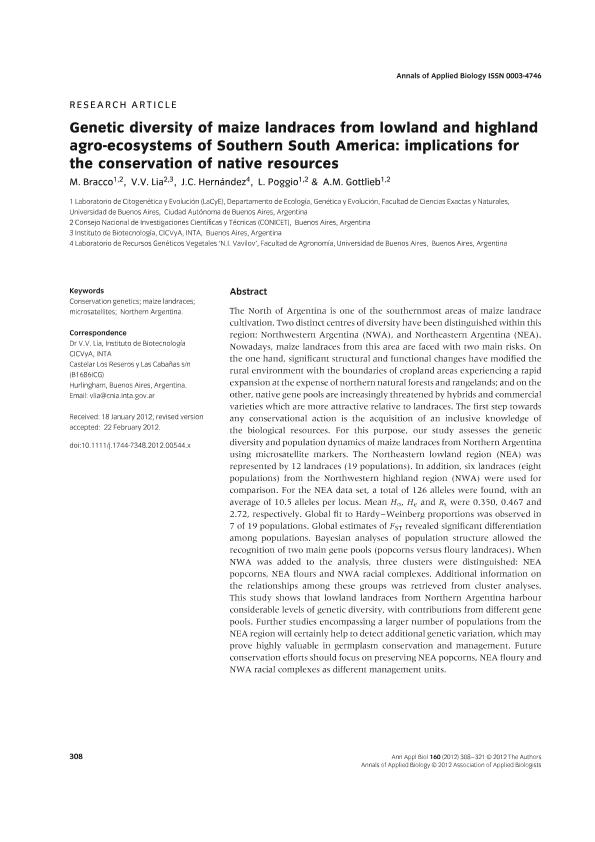Mostrar el registro sencillo del ítem
dc.contributor.author
Bracco, Mariana

dc.contributor.author
Lia, Verónica Viviana

dc.contributor.author
Hernández, J. C.
dc.contributor.author
Poggio, Lidia

dc.contributor.author
Gottlieb, Alexandra Marina

dc.date.available
2019-01-29T17:57:30Z
dc.date.issued
2012-05
dc.identifier.citation
Bracco, Mariana; Lia, Verónica Viviana; Hernández, J. C.; Poggio, Lidia; Gottlieb, Alexandra Marina; Genetic diversity of maize landraces from lowland and highland agro-ecosystems of Southern South America: Implications for the conservation of native resources; Wiley Blackwell Publishing, Inc; Annals of Applied Biology; 160; 3; 5-2012; 308-321
dc.identifier.issn
0003-4746
dc.identifier.uri
http://hdl.handle.net/11336/68865
dc.description.abstract
The North of Argentina is one of the southernmost areas of maize landrace cultivation. Two distinct centres of diversity have been distinguished within this region: Northwestern Argentina (NWA), and Northeastern Argentina (NEA). Nowadays, maize landraces from this area are faced with two main risks. On the one hand, significant structural and functional changes have modified the rural environment with the boundaries of cropland areas experiencing a rapid expansion at the expense of northern natural forests and rangelands; and on the other, native gene pools are increasingly threatened by hybrids and commercial varieties which are more attractive relative to landraces. The first step towards any conservational action is the acquisition of an inclusive knowledge of the biological resources. For this purpose, our study assesses the genetic diversity and population dynamics of maize landraces from Northern Argentina using microsatellite markers. The Northeastern lowland region (NEA) was represented by 12 landraces (19 populations). In addition, six landraces (eight populations) from the Northwestern highland region (NWA) were used for comparison. For the NEA data set, a total of 126 alleles were found, with an average of 10.5 alleles per locus. Mean H o, H e and R s were 0.350, 0.467 and 2.72, respectively. Global fit to Hardy-Weinberg proportions was observed in 7 of 19 populations. Global estimates of F ST revealed significant differentiation among populations. Bayesian analyses of population structure allowed the recognition of two main gene pools (popcorns versus floury landraces). When NWA was added to the analysis, three clusters were distinguished: NEA popcorns, NEA flours and NWA racial complexes. Additional information on the relationships among these groups was retrieved from cluster analyses. This study shows that lowland landraces from Northern Argentina harbour considerable levels of genetic diversity, with contributions from different gene pools. Further studies encompassing a larger number of populations from the NEA region will certainly help to detect additional genetic variation, which may prove highly valuable in germplasm conservation and management. Future conservation efforts should focus on preserving NEA popcorns, NEA floury and NWA racial complexes as different management units.
dc.format
application/pdf
dc.language.iso
eng
dc.publisher
Wiley Blackwell Publishing, Inc

dc.rights
info:eu-repo/semantics/openAccess
dc.rights.uri
https://creativecommons.org/licenses/by-nc-sa/2.5/ar/
dc.subject
Conservation Genetics
dc.subject
Maize Landraces
dc.subject
Microsatellites
dc.subject
Northern Argentina
dc.subject.classification
Otras Ciencias Biológicas

dc.subject.classification
Ciencias Biológicas

dc.subject.classification
CIENCIAS NATURALES Y EXACTAS

dc.title
Genetic diversity of maize landraces from lowland and highland agro-ecosystems of Southern South America: Implications for the conservation of native resources
dc.type
info:eu-repo/semantics/article
dc.type
info:ar-repo/semantics/artículo
dc.type
info:eu-repo/semantics/publishedVersion
dc.date.updated
2019-01-28T14:13:50Z
dc.journal.volume
160
dc.journal.number
3
dc.journal.pagination
308-321
dc.journal.pais
Reino Unido

dc.journal.ciudad
Londres
dc.description.fil
Fil: Bracco, Mariana. Universidad de Buenos Aires. Facultad de Ciencias Exactas y Naturales. Departamento de Ecología, Genética y Evolución. Laboratorio de Citogenética y Evolución; Argentina. Consejo Nacional de Investigaciones Científicas y Técnicas; Argentina
dc.description.fil
Fil: Lia, Verónica Viviana. Instituto Nacional de Tecnología Agropecuaria. Centro de Investigación en Ciencias Veterinarias y Agronómicas. Instituto de Biotecnología; Argentina. Consejo Nacional de Investigaciones Científicas y Técnicas; Argentina
dc.description.fil
Fil: Hernández, J. C.. Instituto Nacional de Tecnología Agropecuaria. Centro de Investigaciones Agropecuarias. Instituto de Fisiología y Recursos Genéticos Vegetales; Argentina
dc.description.fil
Fil: Poggio, Lidia. Universidad de Buenos Aires. Facultad de Ciencias Exactas y Naturales. Departamento de Ecología, Genética y Evolución. Laboratorio de Citogenética y Evolución; Argentina. Consejo Nacional de Investigaciones Científicas y Técnicas; Argentina
dc.description.fil
Fil: Gottlieb, Alexandra Marina. Universidad de Buenos Aires. Facultad de Ciencias Exactas y Naturales. Departamento de Ecología, Genética y Evolución. Laboratorio de Citogenética y Evolución; Argentina. Consejo Nacional de Investigaciones Científicas y Técnicas; Argentina
dc.journal.title
Annals of Applied Biology

dc.relation.alternativeid
info:eu-repo/semantics/altIdentifier/doi/http://dx.doi.org/10.1111/j.1744-7348.2012.00544.x
dc.relation.alternativeid
info:eu-repo/semantics/altIdentifier/url/https://onlinelibrary.wiley.com/doi/abs/10.1111/j.1744-7348.2012.00544.x
Archivos asociados
